
NWLPWG
Namibian Wildlife Lead (Pb) Poisoning Working Group (NWLPWG)
About
The Namibian Wildlife Lead (Pb) Poisoning Working Group (NWLPWG) was established in 2021 and comprises individuals and organisations that work alongside the Ministry of Environment, Forestry and Tourism (MEFT) to address the issue of lead toxicity in scavengers, and associated issues, in Namibia.
The issue of lead (Pb) toxicity in scavengers, particularly vultures, has been of concern for many years. The main source of lead is from ammunition, in the body or body parts of animals left in the veld after hunting, harvesting, culling or predator control. The people involved are thus hunters, farmers, harvesting and culling teams and predator control clubs and specialists. Hunting is coming under greater international pressure, so the sector needs to be seen to be progressive, professional and having high environmental standards. There is now a large body of evidence on the levels and impact of lead in scavengers – particularly vultures and condors – published in the international scientific literature, as well as good information on lead in vultures in Southern Africa. In addition, more manufacturers are now providing a wide range of lead-free ammunition, including in Southern Africa.
The NWLPWG aims to identify options for how Namibia could address the issue, and to explore the potential for regional collaboration. Most vulture species cover huge areas as they search for food. Individual vultures which have been fitted with GPS backpacks in Namibia have been recorded covering five other countries – Angola, Botswana, Zambia, Zimbabwe and South Africa. The same has been found for vultures fitted with GPS backpacks in neighbouring countries. Vulture populations are thus not national, but regional and the problem of lead poisoning is thus also a regional one.
NWLPWG Members
Chair:
Ministry of Environment, Forestry and Tourism, represented by Kenneth /Uiseb.
Vice Chair:
University of Namibia, represented by Lorinda Hart.
Secretariat:
Chris Brown and NCE: ceo@n-c-e.org.
If you are interested in joining NWLPWG please contact the Secretariat. Membership is free.
Member Organisations:
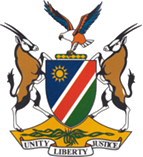
Ministry of Agriculture, Water & Land Reform: Central Veterinary Laboratory

Ministry of Environment, Forestry and Tourism

Ministry of Health & Social Services
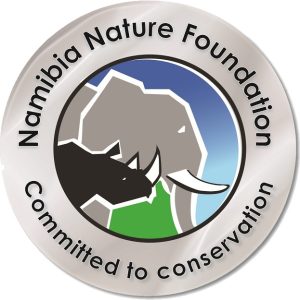
Namibia Nature Foundation
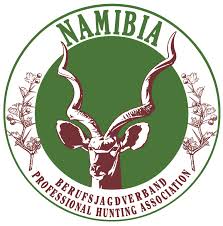
Namibia Professional Hunting Association

Namibian Chamber of Environment

University of Namibia: School of Science

University of Namibia: School of Veterinary Medicine
Working Group documents
| MINUTES – 3rd Lead Poisoning WG meeting (16 Nov 2022).pdf | |
| MINUTES – 2nd Lead Poisoning WG meeting (27 Oct 2021).pdf | |
| EU (ECHA) restrictions of lead (Pb) for ammunition and sinkers.pdf
Letter to European Chemicals Agency (ECHA) from NCE supporting the proposed EU ban on lead (Pb) ammunition and fishing weights |
|
| MINUTES – 1st Lead Poisoning WG meeting (31 Aug 2021).pdf | |
| Summary Zoom meeting lead (Pb) ammunition.pdf
Summary of Zoom meeting on lead (Pb) from ammunition in scavengers, particularly vultures – how best to address this situation in Namibia? |
The issues
Summarised from: https://conservationnamibia.com/blog/b2021-unleaded-please.php
Lead is a toxic substance with well-known negative impacts on human health which are particularly severe for children and pregnant women. Children absorb lead into their bloodstream more readily than adults, while lead consumption in pregnant women may cause developmental problems in unborn babies. Health researchers have not been able to determine a safe level of lead in the human body, and lead accumulates in the body over time. Consuming even tiny amounts of lead regularly is therefore likely to cause long-term health problems. That knowledge resulted in leaded petrol being phased out, along with a host of other legislation restricting the use of lead.
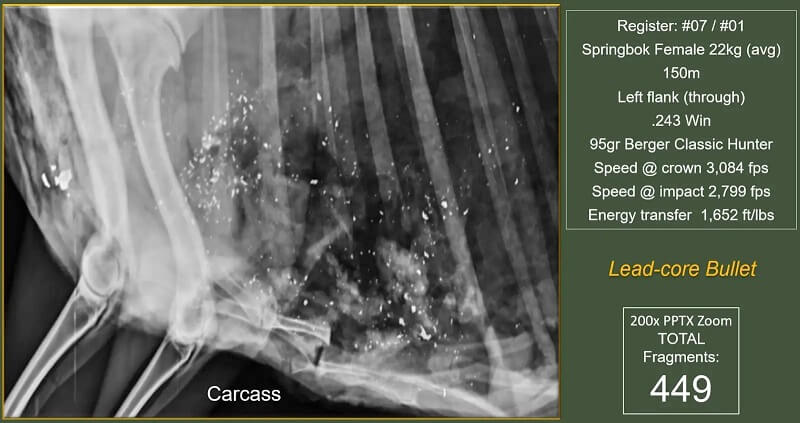
© CHASA and Natshoot
Lead bullets are a particular threat to human health in Namibia, because many people eat game meat from hunts with lead bullets. When a lead bullet hits its target, it fragments into tiny pieces which are not visible to the naked eye and are readily absorbed in the blood stream if consumed.
Lead is also an environmental hazard, and there are no safe levels of lead for any biological organism to consume. Most bullets and fishing sinkers still contain lead, both of which are used for outdoors activities and therefore inevitably land up in the environment. Scientific evidence shows that lead poisoning through bullet consumption by scavenging bird species in Europe and North America is threatening their health and reproduction and recent studies from South Africa and Botswana have shown that white-backed vultures (adults, juveniles and chicks) had blood lead levels higher than expected from background exposure. Chronic lead exposure destroys the neurological system and vultures with high levels of lead in their bodies can be lethargic, anorexic and weak, among other things. Even if the bird does not die due to lead itself, these symptoms reduce its reproductive success and could make it more vulnerable to other causes of death.
The solution: The problem of lead poisoning in humans and vultures due to ingesting bullet fragments from game meat and carcasses is solvable. The solution is to switch to non-lead ammunition.
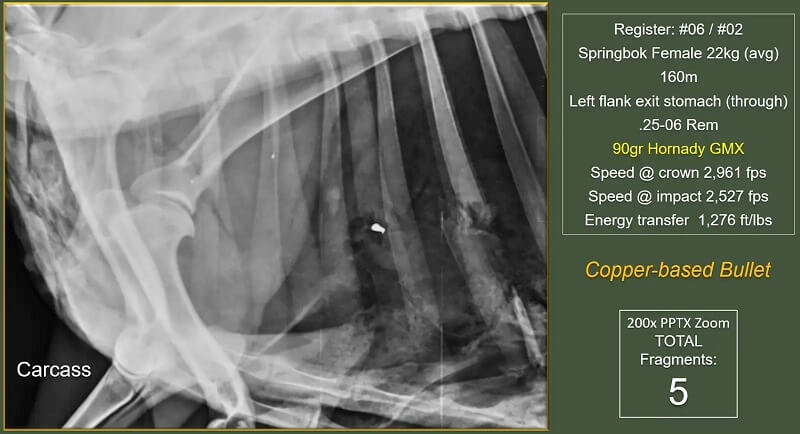
© CHASA and Natshoot
It is time for hunters and fishers, who enjoy activities that are supported by a healthy environment (and often eat what they kill), to remove lead entirely from the hunting and fishing equation. Studies from North America and Europe, where non-lead ammunition has been manufactured for several decades, show that non-lead bullets perform as well or better than lead bullets. A South African manufacturer has started producing non-lead ammunition and some southern African conservation organisations have already switched to lead-free ammunition for their culling operations. Going lead free will improve the safety of game meat for human consumption within Namibia and help to open up export markets.
Thus, the ultimate aim of the NWLPWG is to facilitate the transition from lead to non-lead bullets as quickly as possible, which will be better for our health and our environment.
Activities
Priorities and actions include:
Incentivising the transition of hunting and wildlife sector to lead-free ammunition
- Information on the negative impacts of lead ammunition
- Information on lead-free alternatives (including German calibre firearms)
- Testing of lead-free ammunition, such as copper ammunition
- Engagement with NAPHA
- Engagement re an environmental levy on lead ammunition, and waiver of taxes on lead-free ammunition
- Research into levels of lead in wildlife meat on markets
- Support MEFT to transition to using to lead-free ammunition
Monitoring and research
- Monitor lead levels in blood and feathers of wild-captured vultures
- Monitor lead levels in bones of dead vultures and selected carnivores
- Monitor lead levels in people working with wildlife, and in commercially sold game meat and game products
- Survey arms dealer regarding the types of ammunition sold
See the Resources section for outputs of these actions.
Resources
2024 MEFT Lead Awareness Workshop
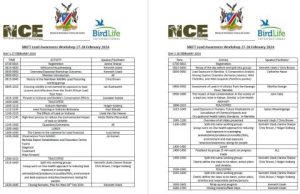
00 MEFT Lead Awareness Agenda 27-28 February 2024
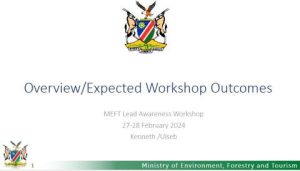
01 Overview & Expected Workshop Outcomes – Kenneth Uiseb

02 History of the Namibian Wildlife Lead (Pb) Poisoning Working Group – Chris Brown
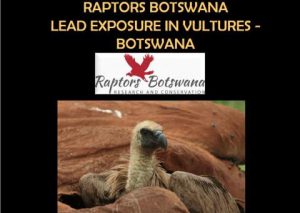
03 Lead exposure in vultures Botswana – Raptors Botswana

04 Lead poisoning in South Africa’s Cape and White-backed Vultures – Linda van den Heever
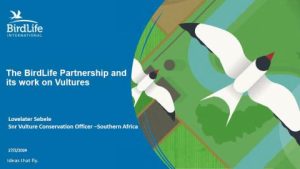
05 The BirdLife Partnership and its work on Vultures – Lovelater Sebele
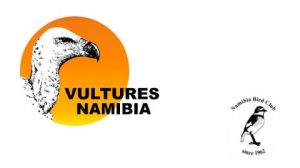
06 Vultures Namibia – Holger Kolberg
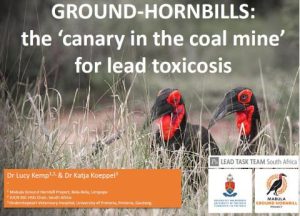
07 Ground hornbills – the canary in the coalmine for lead toxicosis – Lucy Kemp & Katja Koeppel
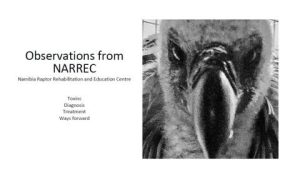
08 Observations from NARREC – Liz Komen
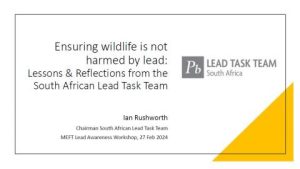
09 Ensuring wildlife is not harmed by lead. Lessons & reflections from the South African Lead Task Team

10 Lead exposure in Namibia – A comparative analysis among captive cheetahs, wild cheetahs and wild leopards – Catherine Hauw
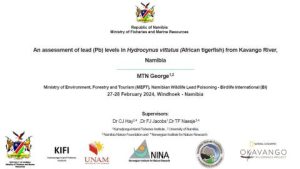
11 An assessment of lead levels in African tigerfish from Kavango River, Namibia – Martha George
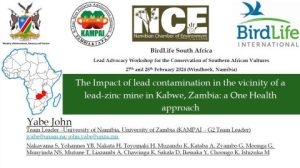
12 The Impact of lead contamination in the vicinity of a lead-zinc mine in Kabwe, Zambia – John Yabe
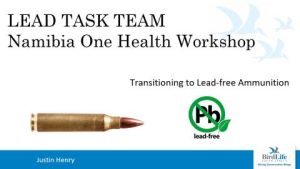
13 Transitioning to Lead-free Ammunition – Justin Henry
General
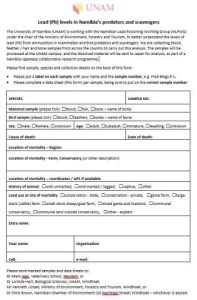
Lead (Pb) levels in Namibia’s predators and scavengers – data form for samples
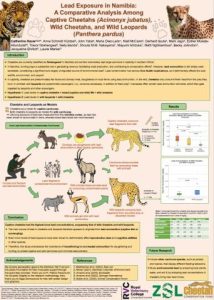
Lead exposure in Namibia: A comparative analysis among captive and wild cheetahs and wild leopards
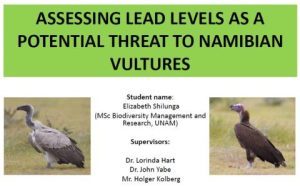
Presentation of research into Assessing lead levels as a potential threat to Namibian vultures: Elizabeth Shilunga
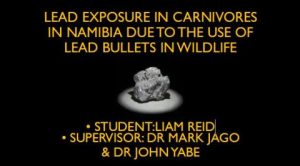
Presentation of research into Lead exposure in carnivores in Namibia due to the use of lead bullets: Liam Reid
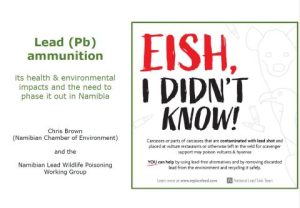
Presentation on Lead (Pb) ammunition, its health & environmental impacts and the need to phase it out in Namibia
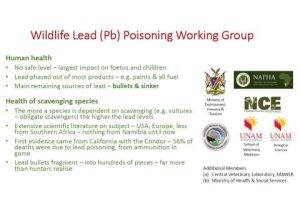
Presentation on NWLPWG, key issues and research results
Talks and Videos
International
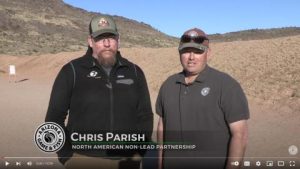
Allen Zufelt & Chris Parish – Lead v Non Lead Bullet Demo
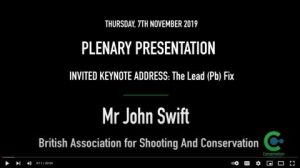
John Swift – Lead in Wildlife and the Environment
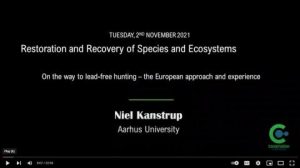
Niel Kanstrup – On the way to lead-free hunting – The European approach & experience
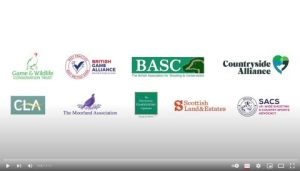
Shooting and rural organisations take responsibility of move away from lead ammunition
Southern Africa
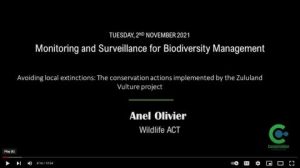
Anel Olivier – Avoiding local extinctions: Conservation by the Zululand Vulture Project
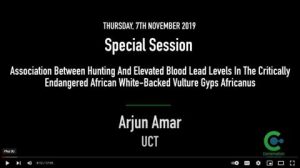
Arjun Amar – Hunting and elevated blood lead levels in the African White-backed Vulture

Ian Rushworth – The SA Lead Task Team: A collaborative approach to a complex problem
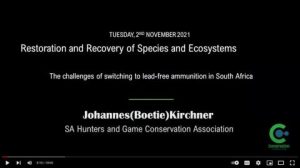
Johannes Kirchner – The challenges of switching to lead-free ammunition in RSA
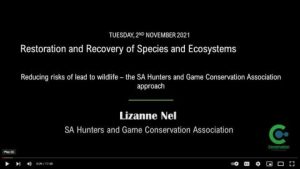
Lizanne Nel – Reducing risks of lead to wildlife – The SA HGCA approach
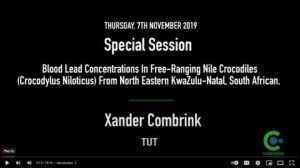
Xander Combrink – Blood lead concentrations in free-ranging Nile crocodiles
Other
Berny P et al. 2015. Vigilance poison: Illegal poisoning and lead intoxication are the main factors affecting avian scavenger survival in the Pyrenees (France). Ecotoxicology and Environmental Safety 118 71-82. https://doi.org/10.1016/j.ecoenv.2015.04.003. Download this resource from the EIS eLibrary
Ecke F et al. 2017. Sublethal lead exposure alters movement behavior in free-ranging golden eagles. Environmental Science and Technology 51 5729-5736. https://doi.org/10.1021/acs.est.6b06024. Download this resource from the EIS eLibrary
Gangoso L et al 2009. Long-term effects of lead poisoning on bone mineralization in vultures exposed to ammunition sources. Environmental Pollution 157 569-574. https://doi.org/10.1016/j.envpol.2008.09.015. Download this resource from the EIS eLibrary
Garbett R 2018. Conservation of raptors and vultures in Botswana: with a focus on lappet-faced vultures Torgos tracheliotos. PhD Thesis. University of Cape Town. Download this resource from the EIS eLibrary
Garbett R et al. 2018. Association between hunting and elevated blood lead levels in the critically endangered African white-backed vulture Gyps africanus. Science of The Total Environment (630) 1654-1665. https://doi.org/10.1016/j.scitotenv.2018.02.220. Download this resource from the EIS eLibrary
Gil-Sánchez JM et al. 2018. From sport hunting to breeding success: Patterns of lead ammunition ingestion and its effects on an endangered raptor. Science of The Total Environment (613-614) 483-491. https://doi.org/10.1016/j.scitotenv.2017.09.069. Download this resource from the EIS eLibrary
Green RE & Pain DJ 2019. Risks to human health from ammunition-derived lead in Europe. Ambio 48 954-968. https://doi.org/10.1007/s13280-019-01194-x. Download this resource from the EIS eLibrary
Gremse F et al 2014. Performance of lead-free versus lead-based hunting ammunition in ballistic soap. PLoS ONE 9 (7) e102015. https://doi.org/10.1371/journal.pone.0102015. Download this resource from the EIS eLibrary
Haig SM et al. 2014. The persistent problem of lead poisoning in birds from ammunition and fishing tackle. The Condor 116 (3) 408-428. https://doi.org/10.1650/CONDOR-14-36.1. Download this resource from the EIS eLibrary
Hampton JO et al. 2021. Portable X-ray fluorescence for bone lead measurements of Australian eagles. Science of the Total Environment 789. https://doi.org/10.1016/j.scitotenv.2021.147998. Download this resource from the EIS eLibrary
Humphries M et al. 2022. High lead exposure and clinical signs of toxicosis in wild Nile crocodiles (Crocodylus niloticus) from a World Heritage site: Lake St Lucia estuarine system, South Africa. Chemosphere 303. https://doi.org/10.1016/j.chemosphere.2022.134977. Download this resource from the EIS eLibrary
Jenni L et al 2015 The frequency distribution of lead concentration in feathers, blood, bone, kidney and liver of golden eagles Aquila chrysaetos: insights into the modes of uptake. Journal of Ornithology 156, 1095–1103. https://doi.org/10.1007/s10336-015-1220-7. Download this resource from the EIS eLibrary
Kelly TR et al 2011. Impact of the California lead ammunition ban on reducing lead exposure in golden eagles and turkey vultures. PLoS ONE 6:4. Download this resource from the EIS eLibrary
Kenny D et al. 2015. Blood lead levels in White-Backed Vultures (Gyps africanus) from Botswana, Africa. Vulture News 68 25-31. https://doi.org/10.4314/vulnew.v68i1.2. Download this resource from the EIS eLibrary
Koeppel KN & Kemp LV 2015. Lead toxicosis in a southern ground hornbill Bucorvus leadbeateri in South Africa. Journal of Avian Medicine and Surgery 29 (4) 340–344. Download this resource from the EIS eLibrary
Krüger SC 2018. Lead exposure in the critically endangered bearded vulture (Gypaetus barbatus) population in southern Africa. Journal of Raptor Research 52 (4) 491-499. Download this resource from the EIS eLibrary
Legagneux P et al. 2014. High risk of lead contamination for scavengers in an area with high moose hunting success. PLoS ONE 9 (11) e111546. https://doi.org/10.1371/journal.pone.0111546. Download this resource from the EIS eLibrary
Martin A et al. 2017. Hunting of roe deer and wild boar in Germany: Is non-lead ammunition suitable for hunting?. PLoS ONE 12:9 e0185029. https://doi.org/10.1371/journal.pone.0185029. Download this resource from the EIS eLibrary
McCann BE et al 2016. Efficacy of non-lead ammunition for culling elk at Theodore Roosevelt National Park. Human-Wildlife Interactions 10 (2) 268-282. Download this resource from the EIS eLibrary
Naidoo V et al. 2017. Lead ingestion as a potential contributing factor to the decline in vulture populations in southern Africa. Environmental Research 152 150-156. http://dx.doi.org/10.1016/j.envres.2016.10.013. Download this resource from the EIS eLibrary
Nkosi DV et al. 2022 Toxic metals in meat contributed by helicopter and rifle thoracic killing of game meat animals. Appl. Sci. 12, 8095. https://doi.org/10.3390/app12168095. Download this resource from the EIS eLibrary
Oxpeckers Investigative Environmental Journalism. Zambia tallies the costs of mining for electric batteries. https://oxpeckers.org/2024/04/zambia-electric-vehicles/. Go to this link
Pain DJ et al. 2019. Wildlife, human and environmental costs of using lead ammunition: An economic review and analysis. Ambio 48 969-988. https://doi.org/10.1007/s13280-019-01157-2. Download this resource from the EIS eLibrary
Stroud RK & Hunt WG 2009. Gunshot wounds: A source of lead in the environment. In RT Watson et al (Eds.). Ingestion of lead from spent ammunition: Implications for wildlife and humans. 119-125. The Peregrine Fund. Download this resource from the EIS eLibrary
Thomson GC 2021. How do you like your meat? Unleaded, please! https://conservationnamibia.com/blog/b2021-unleaded-please.php. Go to this link
van den Heever L et al. 2019. Blood and bone lead levels in South Africa’s Gyps vultures: Risk to nest-bound chicks and comparison with other avian taxa. Science of the Total Environment 669 471-480. https://doi.org/10.1016/j.scitotenv.2019.03.123. Download this resource from the EIS eLibrary
van den Heever L et al. 2022. Identifying the origin of lead poisoning in white-backed vulture (Gyps africanus) chicks at an important South African breeding colony: a stable lead isotope approach. Environmental Science and Pollution Research. https://doi.org/10.1007/s11356-022-23209-z. Download this resource from the EIS eLibrary
How can you help?
Transition to, or help to test, alternatives to lead ammunition and lead fishing sinkers
There are now viable alternatives. Get in touch to get involved.
Remove any lead you encounter in the environment
Remove bullets and sinkers, as well as lead-contaminated meat which scavengers could consume.
Spread awareness about the impacts of lead in the environment
Share and discuss the information on this website with hunters, fishers, tourism operators and others.
Contribute to research on Lead (Pb) levels in Namibia’s predators and scavengers
The University of Namibia (UNAM) is working with the Namibian Wildlife Lead (Pb) Poisoning Working Group (NWLPWG) under the chair of the Ministry of Environment, Forestry and Tourism, to better understand the levels of lead (Pb) from ammunition in mammalian and bird predators and scavengers. We are collecting blood, feather/hair and bone samples from across the country to carry out this analysis. The samples will be processed at the UNAM campus, and the dissolved material will be sent to Japan for analysis, as part of a Namibia-Japanese collaborative research programme.
The data form includes full information on the samples requested, how to collect them and how to arrange collection. Download the data form here.
Useful links
The Lead Ammunition Group: A UK process for assessing and addressing the risks from lead ammunition
Contact
Secretariat services are currently provided by NCE: admin@n-c-e.org.
